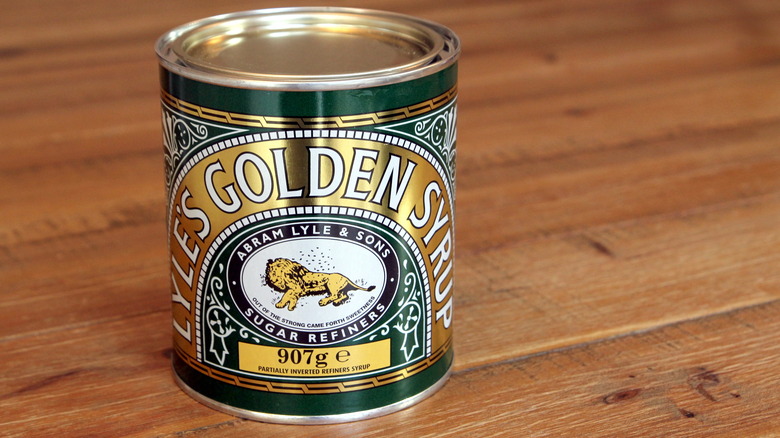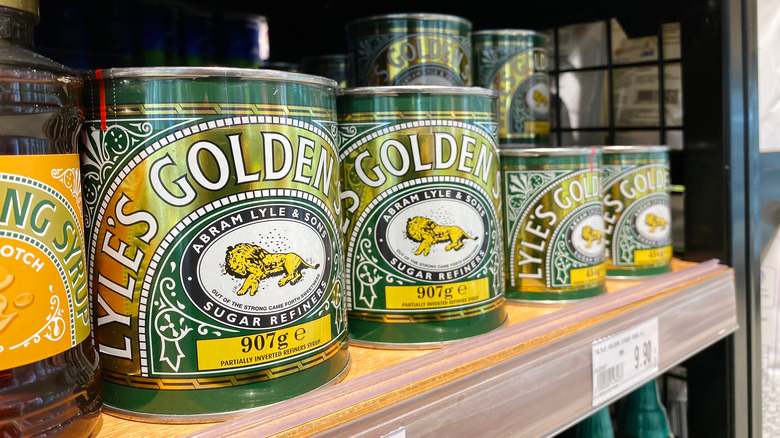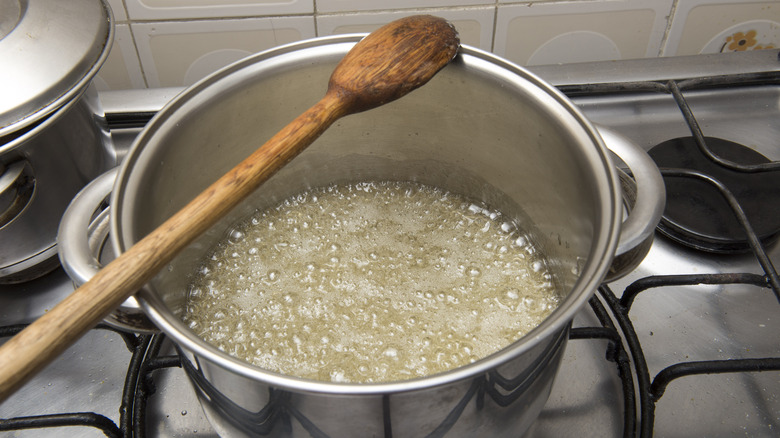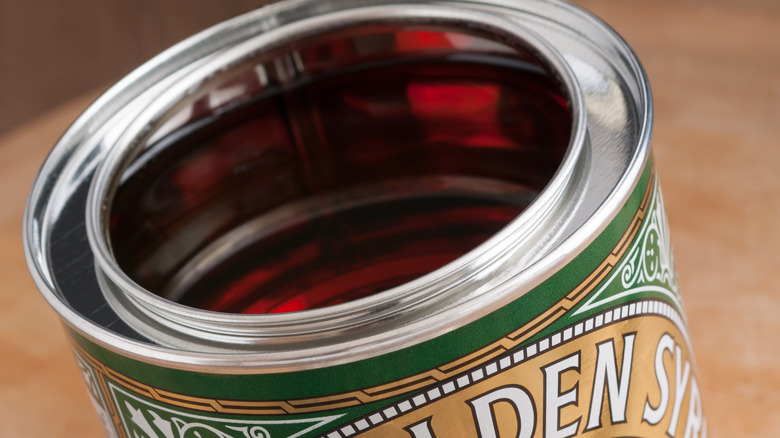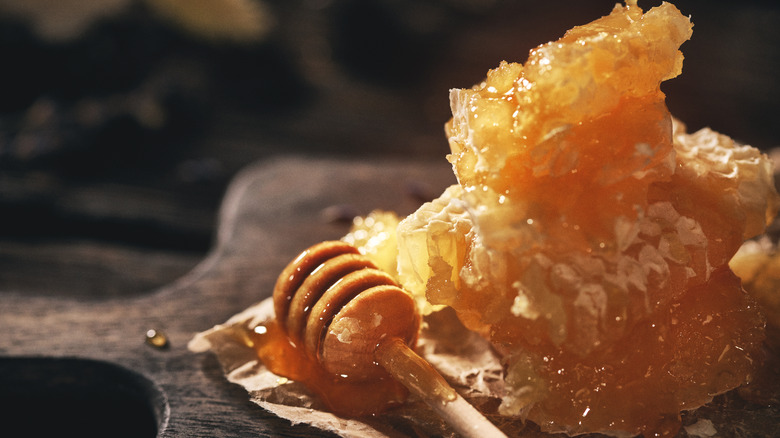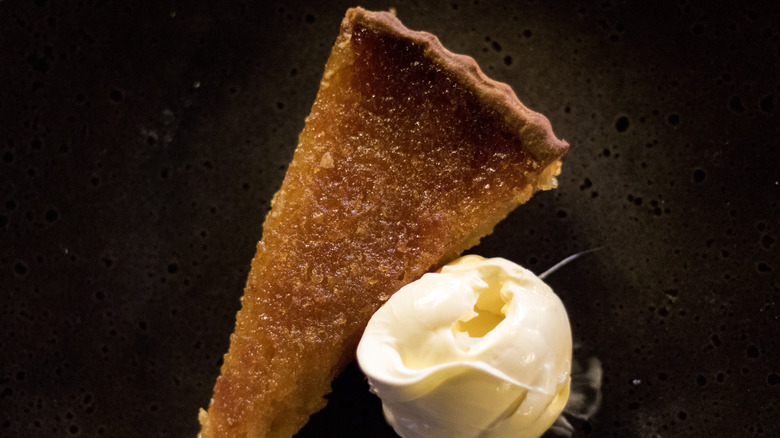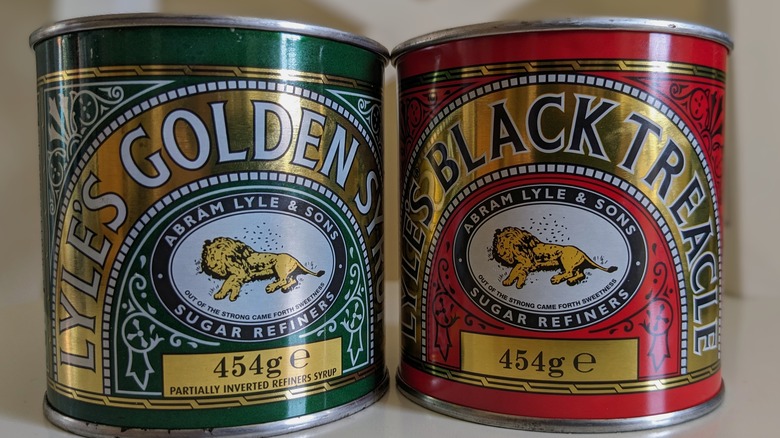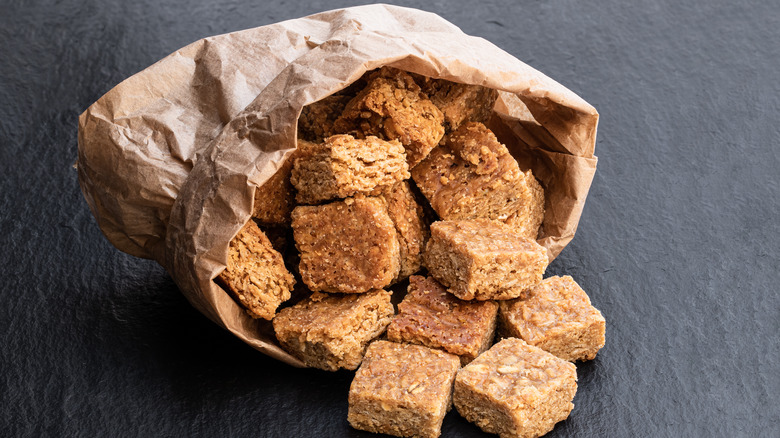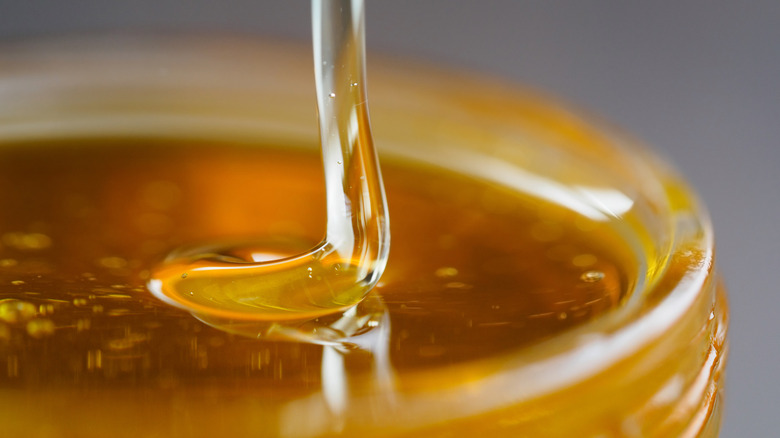What Is Golden Syrup And How Do You Use It?
We may receive a commission on purchases made from links.
Many people keep molasses, honey, maple syrup, and corn syrup in their pantries, but people who don't live in the United Kingdom may not know what golden syrup is or its delectable properties. Golden syrup is a rich sugar syrup used for sweetening many items from beverages to breakfasts. Made of sugarcane or sugar beets, this syrup is cooked into a golden amber color that some people may misidentify as honey — which it often substitutes for.
Golden syrup was popularized by businessman Abram Lyle when, in 1881, he opened his refinery in East London to produce it commercially. Lyle's Golden Syrup was born and soon became a staple in households throughout the United Kingdom.
The syrup is so popular because of its simplicity, long shelf life, brand identity connected to Lyle's Golden Syrup, and its ability to easily incorporate into many different recipes. We researched several different outlets and recipes to answer basic questions like golden syrup's origins, how to make it at home, and what treats to make with it. From Lyle's to a homemade jar, this handy little syrup is a versatile ingredient many households can't do without.
What is golden syrup?
Golden syrup is a refined sugar syrup with an amber color used mostly in baking or stirred into beverages. The syrup can be homemade or commercially produced. It is often compared to treacle, molasses, honey, and expensive maple syrup, all of which it can substitute for in recipes (including when making brown sugar at home).
After the company's founding in 1881, Abram Lyle gathered food chemists to formulate an alternative to dark treacle molasses, which was a waste product of sugar refining. Golden syrup was invented and hailed as a more palatable sweetener that could be produced and marketed to the nation. The company took off and became widely recognized for its signature dark-green can with golden lettering and a logo of a lion with bees buzzing around it. As the story goes, this logo was inspired by Lyle's deep religious beliefs, and the logo references the Old Testament story of Samson's lion and bees.
Lyle's Golden Syrup continued its fixed importance in the United Kingdom throughout the next century and into the modern era. In 1922, the brand started advertising itself with a Royal Warrant after King George V expressed his love for the product. In 2007, the company won a Guinness World Record for the world's oldest unchanged brand packaging. People nowadays enjoy Lyle's Golden Syrup worldwide; some have taken to replicating the syrup recipe in their home kitchens.
How is golden syrup made?
Golden syrup is a simple product you can make at home with just three ingredients. Because of the cooking process and ingredients, the syrup is less likely to crystalize than corn syrups and comes out viscous, smooth, and sweet. All one has to do is boil water and sugar in a saucepan, stirring regularly. The ingredients will cook together, creating an inverted sugar where the bonds between fructose and glucose break resulting in a thick, sticky liquid — 50% fructose and 50% glucose. A citric acid like lemon juice or cream of tartar is added to speed up the process, and the mixture will begin to carmelize at a lower temperature. The final product is an amber-gold syrup that has the consistency of honey.
Golden syrup's commercial producers follow the same process with a few extra steps to account for resource allocation and larger quantities. Many manufacturers may use beet sugar in place of cane sugar because of its economical harvesting process, but it inverts to fructose and glucose via the same process that creates Golden Syrup just the same.
What does golden syrup taste like?
Golden syrup is often compared to other sweeteners but has its own unique flavor profile. It is sweet and caramelly with little buttery flavor, making it ideal for breakfast foods like flapjacks. The syrup has more depth than plain sugar but doesn't overpower the recipes it is incorporated into.
Golden syrup is more neutral and versatile than other syrups. It lacks the distinct bitterness and tang of molasses that pairs nicely with strong flavors like ginger or savory seasonings for sauces. In fact, golden syrup is much more delicate, and although it can be compared to corn syrup, its richness contrasts with the latter's flavor, which can only be described as sweet. Golden syrup and treacle are sometimes used interchangeably, but treacle is a tad richer, whereas golden syrup is the slightest bit lighter. Compared to maple syrup, golden syrup lacks the earthiness and nuttiness that makes maple flavors recognizable. In short, golden syrup has carved out its own, very niche, flavor in the syrup world.
Golden syrup vs. honey
Golden syrup and honey look incredibly similar. They both have a golden-amber hue and sticky viscosity but there are some signature differences in flavor, appearance, and production between the two. Both syrups are inverted sugars, but the most obvious difference is that humans produce golden syrup. Honey is made by bees that collect flower nectar and store it in beehive honeycombs, which break down the pollen through a process of evaporation, turning it into a sweet liquid that is harvested by beekeepers.
Honey contains some antioxidants and vitamins that golden syrup does not have; it was even used for medicinal purposes in ancient times. The two products can replace one another in certain recipes with little impact on the final product. Honey may make baked goods last longer without going stale and add a more floral or herby taste. Honey and golden syrup are both vegetarian, but honey is not vegan because bees are integral to its production; golden syrup is a vegan alternative to honey that many enjoy for its simplicity and similar properties.
How to cook with golden syrup
One of the most popular uses for golden syrup is treacle tart, a traditional British dessert made of a shortbread pastry crust filled with a mixture of golden syrup, egg, and cream, and baked to perfection. It is typically served warmed or with a scoop of ice cream on top. Another popular way to enjoy golden syrup is classic British Flapjacks, an oat bar perfect for snacking or a breakfast to-go. Oats, butter, sugar, and golden syrup are combined and pressed into a pan where they can be cut into bars. Golden syrup is also incredible in puddings of all flavors and varieties.
Golden syrup is a great sweetener in cocktails. It can sometimes replace simple syrup or honey in essential cocktails or be a focal point in drinks like Pimms with golden syrup — a creation of Lyle's.
Aside from that, it can also be a topping or mix-in for more everyday recipes. Many enjoy golden syrup drizzled atop breakfast foods like scones, oatmeal, yogurt, toast, or pancakes (although those always taste better at a restaurant). Some people even use golden syrup as a sweetener in tea and to upgrade cheap coffee.
Where to buy golden syrup
According to Lyle's website, golden syrup is a classic food in the United Kingdom, with Lyle's Golden Syrup being the main producer that churns out more than a million cans monthly. Most people in the U.K. can find golden syrup in grocery store aisles in a can, jar, or squeeze bottle. However, those living in different nations and continents may have a harder time finding the golden stuff. Many outlets like Amazon, Walmart, and Target can get golden syrup in bulk or one-time orders online. One 454-gram can of Lyle's Golden Syrup typically costs around $10. Some American grocery stores stock golden syrup in baking aisles or sometimes international food sections.
If shoppers cannot find golden syrup and need a quick alternative, they can use honey. If honey is unavailable, you can "substitute two parts corn syrup and one part molasses," according to British chef April Bloomfield in her cookbook "A Girl and Her Pig" (via MarthaStewart.com).
Nutritional information about golden syrup
Golden syrup isn't necessarily a health food and is typically categorized as a baking ingredient. The serving size of Lyle's Golden Syrup is 100 grams, equating to nearly ¼ cup, and contains 310 calories, 77.5 grams of carbohydrates, 0.5 grams of protein, and 0.8 grams of sodium. A more personal serving size of golden syrup is about one tablespoon, which contains around 65 calories. Serving sizes will vary, especially because golden syrup is used in baking, drizzled in small amounts on other foods, or mixed with other ingredients.
Comparatively, golden syrup contains relatively similar nutritional information to similar products. Molasses, honey, corn syrup, and maple syrup contain 50 to 60 calories in one tablespoon. Out of each of these options, honey contains the most antioxidants and vitamins. There are certain alternatives to these products that advertise as low-calorie artificial sweeteners, but they will likely taste different or cook similarly because of their differing chemical properties.
How to store golden syrup
Golden syrup sold commercially is typically stored in thick glass jars, tin cans, or plastic squeeze bottles. As long as it is kept unopened and in a cool, dry location like a cupboard or pantry, golden syrup will last up to the expiration date printed on the bottle. After the bottle or container is opened, it lasts three to six months. Fridge storage will affect its viscosity, so keeping golden syrup in a pantry or cabinet is best. The most common sizes for commercial golden syrup are 16 or 32-ounce tin cans, 11.5 or 24.7-ounce plastic bottles with pour tops, or 12-ounce squeeze bottles. Lyle's Golden Syrup also sells maple-flavored golden syrup and dessert sauces.
That said, homemade golden syrup may last longer than the commercially produced version. It is best kept in a glass jar with an airtight lid. Golden syrup is best served at room temperature when used as a topping. Heating or cooling the syrup before drizzling it on oatmeal, yogurt, or beverages may change the viscosity. Putting golden syrup in the fridge may harden it, making it difficult to pour and creating a less desirable texture to eat. Reheating golden syrup or keeping it in a warmer storage area, such as near the oven or cooktop, could make it runnier. Some recipes may call for golden syrup to be heated in a certain way to cooperate in baked goods. In that case, follow the instructions carefully to create the cooking reactions required for a delicious outcome.
